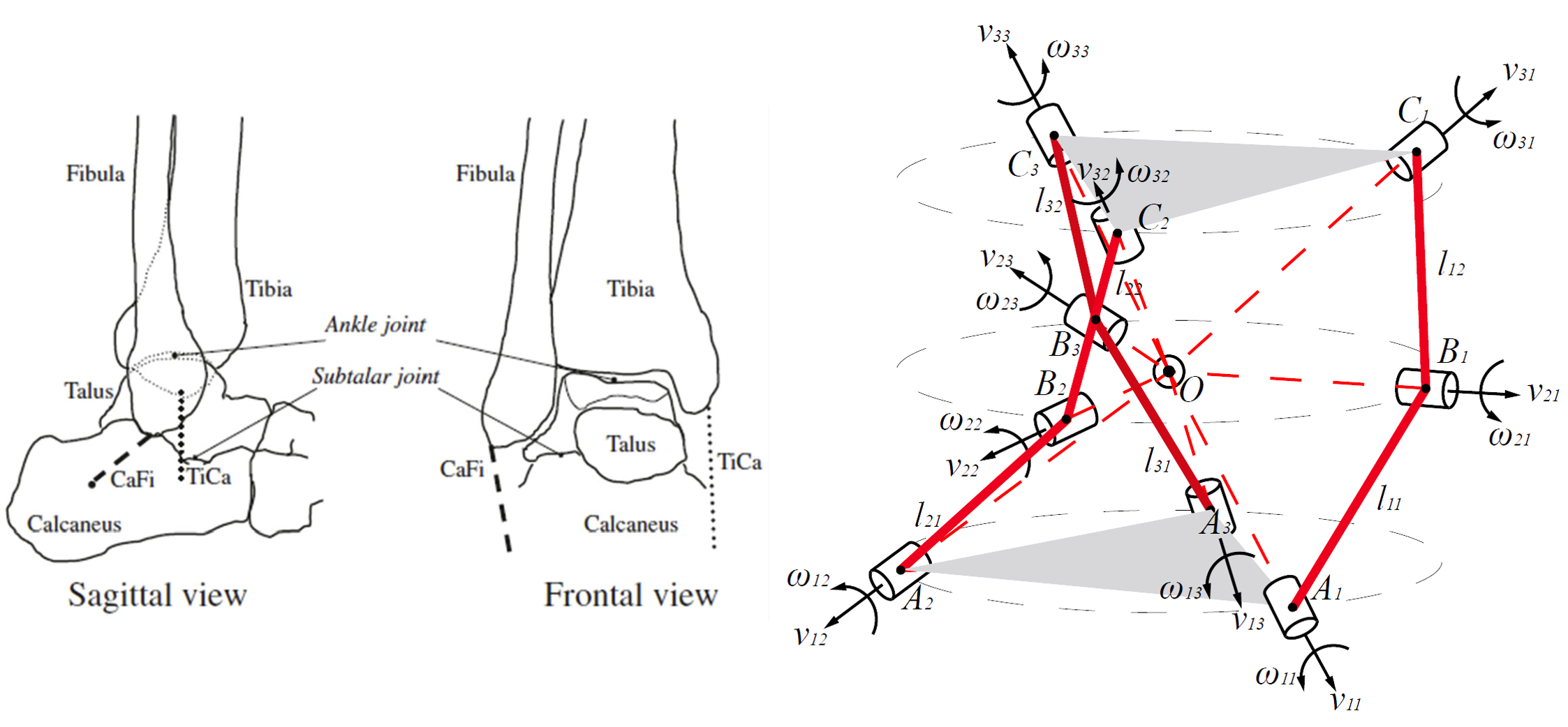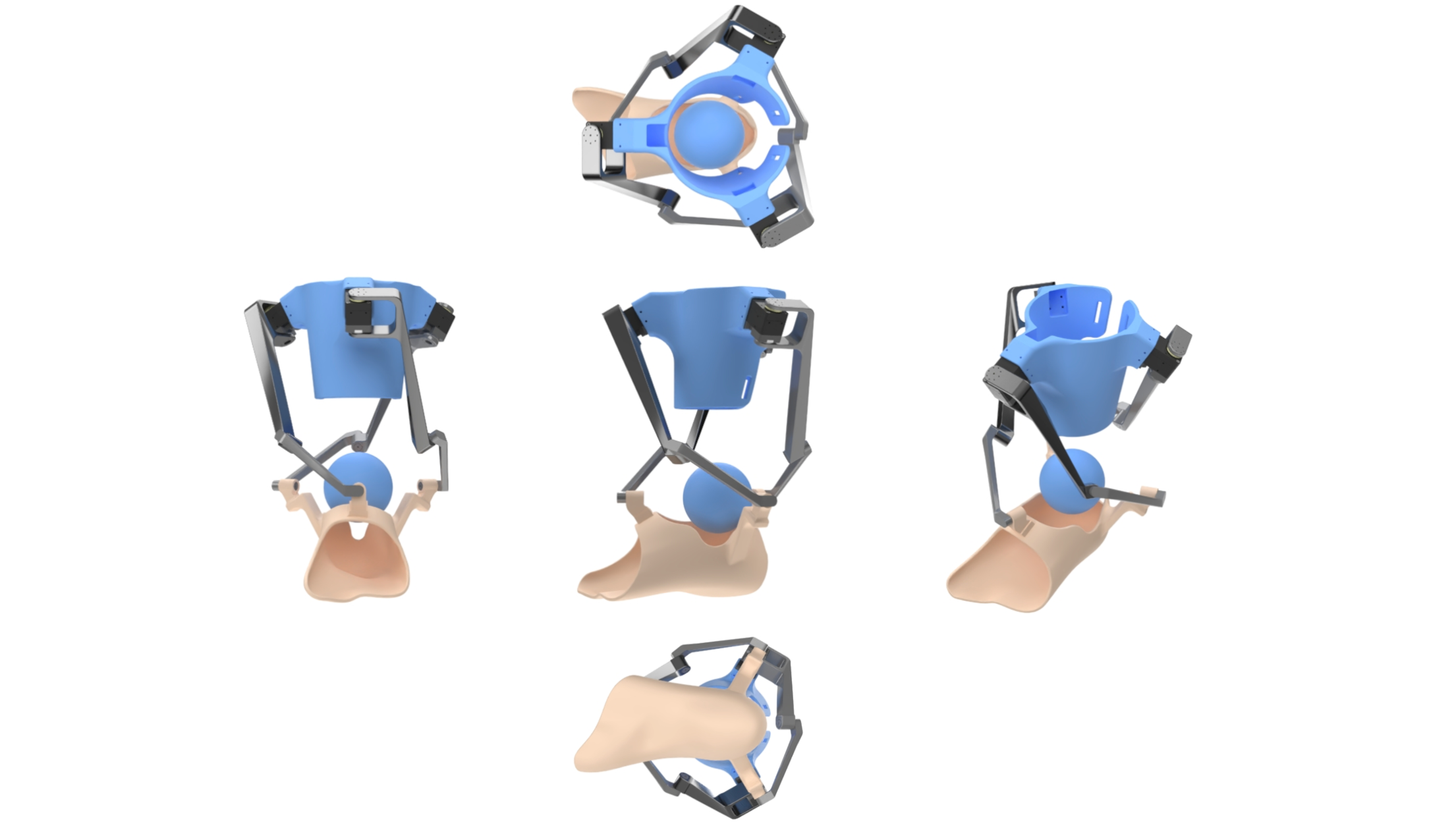This paper presents the development of a wearable ankle rehabilitation robot based on a 3-RRR spherical parallel mechanism (SPM) to support multi-DOF recovery through pitch, roll, and yaw motions. The system features a compact, ergonomic structure designed for comfort, safety, and compatibility with ankle biomechanics. A complete design-to-dynamics pipeline has been implemented, including structural design, kinematic modeling for motion planning, and Lagrangian-based dynamic modeling for torque estimation and simulation analysis. Preliminary simulations verify stable joint coordination and smooth motion tracking under representative rehabilitation trajectories. The control framework is currently being developed to enhance responsiveness across the workspace. Future work will focus on integrating personalized modeling and adaptive strategies to address kinematic singularities through model-based control. This work establishes a foundational platform for intelligent, personalized ankle rehabilitation, enabling both static training and potential extension to gait-phase-timed assistance.
Ankle injuries are prevalent among athletes, postoperative patients, and individuals with neurological impairments. Effective rehabilitation is critical for restoring mobility, strength, and proprioception. However, conventional rehabilitation devices often provide limited degrees of freedom (DOFs), restricting natural joint movement and potentially prolonging recovery.
The human ankle can be biomechanically approximated as a spherical joint with three rotational DOFs: pitch (plantarflexion/dorsiflexion), roll (inversion/eversion), and yaw (internal/external rotation). Although the actual geometric model of the human body corresponds to more complex multi-degree-of-freedom movements, since the joint movements can all be contained within the same envelope surface, the ankle joint can be approximated using a spherical model. To replicate this natural movement, we propose a 3-RRR spherical parallel manipulator (SPM) as the core of a wearable ankle rehabilitation robot.

The 3-RRR spherical parallel mechanism consists of three identical limbs, each with two revolute (R) joints connecting a fixed base to a moving platform. This configuration enables compact, symmetric structures capable of generating three rotational degrees of freedom about a common center of rotation.
The device is designed for direct lower limb attachment, promoting daily use and better patient compliance. Key design considerations include:
Compact Base Ring: Custom-fitted with adjustable straps for secure, comfortable attachment to the lower leg.
Non-Interference Mechanisms: Low-profile limbs and joint housings minimize obstruction to nearby joints and ensure compatibility with footwear and braces.
Device Modularity: Interchangeable links and quick-release fasteners support adjustment across users and rehabilitation stages.

The kinematic analysis establishes the mapping between platform pose and individual joint motions. We first define all symbols, then compare coordinate representations, derive frame transformations, and finally present inverse, forward, and velocity kinematics. These results underpin the dynamic modeling in the following section.
The 3-RRR mechanism consists of three identical kinematic chains, each connecting the base platform to the foot platform through actuated (Ai) and passive (Bi) joints. This configuration enables three rotational degrees of freedom while maintaining structural rigidity.
The system uses Euler angle transformations to map between platform orientation and joint angles:
where α, β, and γ represent the ankle's roll, pitch, and yaw rotations.
The kinematics solution enables bidirectional mapping between:
The velocity relationship is governed by the system Jacobian:
where Jr relates joint velocities to platform angular velocity, critical for smooth motion control.
A comprehensive Lagrangian-based dynamic model was developed to enable accurate torque estimation and simulation analysis. The control framework incorporates PID controllers with tunable compliance characteristics to accommodate different rehabilitation requirements.
The system dynamics are described by the Lagrangian-based equation of motion:
where q = [θ₁, θ₂, θ₃]ᵀ represents the actuator angles, M(q) is the mass matrix, C(q,q̇) captures Coriolis effects, and τ are the applied torques.
The system employs independent PID controllers for each rotational degree of freedom (roll, pitch, yaw), enabling precise motion tracking and adjustable compliance characteristics.
Each axis follows the control law:
where ei = qi,ref - qi is the tracking error for each axis.
The controller gains can be tuned to provide different compliance behaviors:
This adaptability allows the same device to accommodate different stages of patient recovery and therapy requirements.
Preliminary simulations verified stable joint coordination and smooth motion tracking under representative rehabilitation trajectories. The system demonstrated robust performance across different compliance settings, enabling customization for individual patient needs.
Although the 3-RRR SPM is mechanically rigid, tuning feedback gains effectively modulates its compliance characteristics, allowing the same device to provide both gentle assistance and precise control depending on rehabilitation requirements.
The 3-RRR parallel ankle rehabilitation robot addresses several limitations of conventional rehabilitation devices:
Unlike traditional single-axis devices, the system enables simultaneous pitch, roll, and yaw motions that closely replicate natural ankle biomechanics, promoting more effective rehabilitation outcomes.
Adjustable compliance characteristics allow clinicians to customize therapy intensity and assistance levels based on individual patient progress and specific rehabilitation goals.
The compact, lightweight design promotes patient compliance and enables both clinical and home-based rehabilitation scenarios, extending therapy accessibility.
Building on the established foundation, several advanced features are under development:
Integration of in-shoe IMU and plantar-pressure sensing with real-time model personalization will enable dynamic adaptation to individual patient biomechanics and progress.
Comprehensive clinical trials with stroke patients, sports injury cases, and postoperative patients will validate therapeutic effectiveness and inform protocol optimization.
Machine learning algorithms will analyze patient progress patterns to automatically adjust therapy parameters and recommend protocol modifications for optimal recovery outcomes.
This work establishes a comprehensive foundation for 3-RRR parallel ankle rehabilitation robots, from mechanism design through dynamic modeling to control framework development. The systematic approach enables precise motion control while maintaining adaptable compliance characteristics essential for personalized rehabilitation protocols. Future developments will focus on clinical validation and intelligent therapy integration to maximize therapeutic effectiveness and patient outcomes.